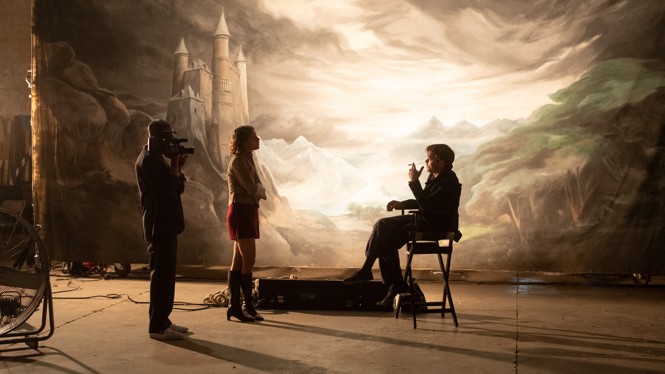Sequels are clogging theaters this fall—just look at the new entries in the James Bond, Venom, Halloween, and Marvel franchises. Joanna Hogg’s The Souvenir Part II is yet another retread, following up on her 2019 movie about a young filmmaker coming of age and navigating a doomed relationship. But this is not a typical sequel, and in a cinematic landscape often dominated by lazy, cash-grab blockbusters, Hogg’s work stands out. While watching a Part 2 of a British independent art film feels strange at moments, the experience is also refreshing.
In continuing her semi-autobiographical tale, Hogg demonstrates the oft-undeployed power of a second entry. She uses the new film not just to push forward the story of Julie (played by Honor Swinton Byrne) but also to consider the character’s past. In the first movie, Julie wanted to be a filmmaker who captured authentic struggle, such as the plight of the British working class under Thatcherism, but her ambitions were sidetracked by her romance with the charming and intense Anthony (Tom Burke), a civil servant who eventually lost his life to his heroin addiction. In The Souvenir Part II, Julie’s renewed thirst for artistic truth leads her to make a film about her own life. In what is both a weird sequel and a self-aware remake, Hogg shows how the creative process can transmute painful memories into beguiling entertainment.
[Read: The Souvenir is a masterly coming-of-age portrait]
Although the first installment seemed to hew closely to Hogg’s life, the second blurs the line between truth and fiction. In reality, Hogg didn’t direct a theatrical feature until 2007’s Unrelated, which came out when she was 47; The Souvenir didn’t come out until she was 59. Part II imagines a world in which she was allowed to make that movie as a much younger person. The film lets Julie make mistakes as she tries to express herself through art, demonstrating both compassion for Hogg’s fictional self and gentle self-critique.

The Souvenir Part II will lack emotional resonance if you haven’t seen the previous chapter (an absolute must-watch that’s available to stream on various platforms). But while The Souvenir gripped because it was such a hermetic, crushing portrait of first love, Part II wisely goes the opposite route. The first film was shot largely at Julie’s small apartment, a claustrophobic venue that emphasized the change in Julie’s relationship with Anthony from comfortable to stifling. Though The Souvenir Part II is set just days after the first ends, it jumps from location to location and hops through time a little more carelessly.
Julie is trying to devote herself back to filmmaking and process her loss. She is no longer the winsome naïf of the first film; Swinton Byrne plays Julie, transformed by Anthony’s death, as more capricious, less vulnerable, and more eager to step into the adult world, though she still lacks so many tools to navigate it. She has an adversarial relationship with her mother, Rosalind (Tilda Swinton, Honor Swinton Byrne’s real-life mother), and stands up to her grad-school teachers when they express concern over her making a movie about her relationship with Anthony. The viewer knows that Julie is often stumbling in the wrong direction, but after the confinement of the previous movie, these failures make her eventual growth that much more satisfying.
Hogg is a meticulous observer of human behavior, good and bad. She loads the most stilted, polite conversation (say, between Julie and her well-meaning mother) with tension. The Souvenir Part II’s meta-narrative follows the development of that skill: Julie, though full of passion as an artist, is still only beginning to learn how to listen to people, to take in experiences and render them powerfully. When she finally shows audiences her completed grad-school project, her new maturity is evident. Hogg depicts the work as a gorgeous, abstract piece of art cinema, a blend of her own youthful obsessions and her present-day experience behind the camera. That transformation is what makes the Souvenir saga such a unique wonder: It’s a specific character study told with the ambition that small, arty projects are rarely afforded—a complex and deeply realized story that not only demanded a second film but actually got one.













